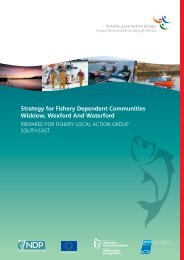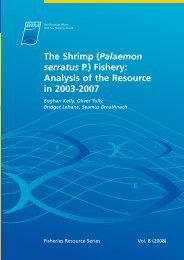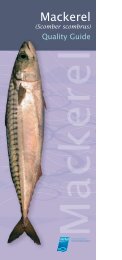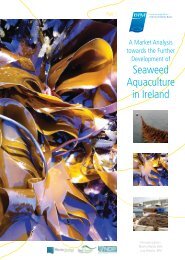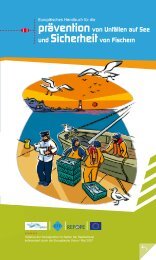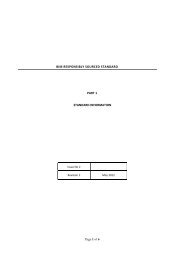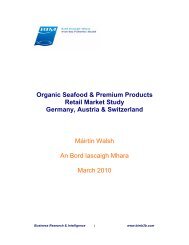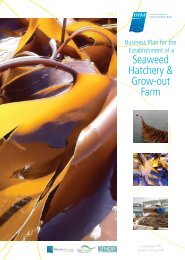Cultivating Palmaria palmata - Bord Iascaigh Mhara
Cultivating Palmaria palmata - Bord Iascaigh Mhara
Cultivating Palmaria palmata - Bord Iascaigh Mhara
Create successful ePaper yourself
Turn your PDF publications into a flip-book with our unique Google optimized e-Paper software.
3.3 Culture medium<br />
The developing sporelings of <strong>Palmaria</strong> are cultivated in seawater supplemented with nutrients. The nutrient<br />
enrichment medium can be prepared in the laboratory or bought as a ready-prepared mixture. All media contain<br />
macro-nutrients such as nitrogen, phosphorus, potassium, magnesium, calcium and sulphur, and micro-nutrients<br />
such as cobalt, iron, manganese, zinc, and vitamins. They vary slightly in their composition (Andersen et al.,<br />
2005; Appendix 2). A common enrichment medium used for red algae is von Stosch. “f2” is a medium frequently<br />
used for cultivating microalgae, but it is also commonly used for a range of macroalgae including <strong>Palmaria</strong>.<br />
These media can be purchased from different aquaculture-supply companies or culture collections (see<br />
Appendix 3).<br />
3.4 Culture substrate and collector preparation<br />
The substrate on which the <strong>Palmaria</strong> tetraspores are settled is<br />
an extremely durable and long-lasting string of 2 mm diameter.<br />
In Asia this string is commonly known as Kuralon (Fig. 3.2) and<br />
frequently used in seaweed aquaculture. It is made of polyvinyl<br />
or polyvinylalcohol fibre (PVA), woven or spun, but has<br />
the appearance of cotton string, i.e. slightly fluffy. To purchase<br />
original Kuralon string from Asia (e.g. China, Japan, Korea) is<br />
complicated unless commercial links are established. Other<br />
types of string were tested in sea trials during the “Seaweed<br />
Aquaculture Project and found suitable, e.g. 1-2 mm polyester<br />
string, spun or woven. Such string can be purchased in Ireland,<br />
the U.K. and other European countries (see supplier list, Appendix 3).<br />
Fig. 3.2. Two types of Kuralon culture string<br />
used in China.<br />
The most space-efficient deployment of <strong>Palmaria</strong>-seeded string is in the form of nets. Using the string described<br />
above, nets can be made with any desired dimension and mesh size. A size of net that has been extensively<br />
tested in the current project is 1.2 m wide x 3 m long, with a 10 x 10 cm mesh size. The length of the net is<br />
limited by the depth to which sufficient light penetrates to support the growth of <strong>Palmaria</strong>. A width of 1.2 m is<br />
suitable because, when seeding the net with spores, it must be folded a few times and then tied to a frame.<br />
Seeded string can also be deployed as droppers. The string is then wrapped around a frame-shaped collector,<br />
with small spaces left between the parallel strings to allow spores to fall through to the string on the underside of<br />
23



